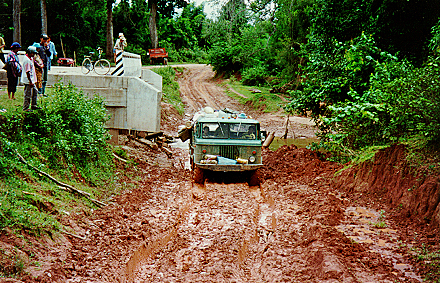In mid 1994 my wife and I set off north on the road that ran between Houayxai and Luang Namtha (northern Laos). Our objective was modest. We wanted to go to a weekly market held in a village just an hour or so along the road. The trip was uneventful. An hour was optimistic, but three hours was not unreasonable given the road conditions. Standing in the back of a truck with local villagers clutching home-made rifles (which reached to just beneath my chin) was disconcerting on a bumpy road, but we reached our destination without mishap.
The market was a small and desultory affair, selling mainly local forest products and dry goods from the stores on Houayxai. We spent a while wandering around the picturesque village (my memory is a bit vague on this and I can’t lay my hands on my notes right now – I think it was Ban Pong, a Lu village). We then asked when the truck would be returning, only to find that it had returned only 5 minutes after arriving. There would be another the next day.
Sleeping at the market was fine (but bathing in the river was not a pretty sight). The stall keepers were friendly and set us up with a mosquito net in one of the small bamboo shops. They fed us fried birds and sticky rice. And when we went to bed they regaled each other with funny stories about the odd questions and strange habits of the falang. The rats were noisy. All good fun.
Well, things are now changing along the road from Houayxai to Luangnamtha. (For some previous New Mandala commentary on this route see here and here.) In a recent contribution to Mekong Currents, Rosalia Sciortino provides a useful profile of recent developments and discusses some of the key social impacts occurring along the route. Here is an extract.
AH3 in Laos traverses a mountainous, predominantly ethnic, area characterised by severe poverty. Still, there are significant gaps between the extremely poor ‘highland’ minorities and the better-off ‘lowland’ communities, the degree of their poverty correlating with degree of benefit from improved transportation. It is the poorest communities — mainly non-Tai villages far from the towns of Namtha and Houayxay – that encounter the greatest challenges, being precluded from new market opportunities by socio-cultural and financial constraints. In the competitive, commercial environment unleashed by the highways, they are posed to lose out to better-equipped newcomers and more privileged local groups, while experiencing a loss of habitat and livelihoods that threaten their very existence.
One of the most direct impacts of road construction is the resettlement of communities to make way for it. For AH3, an Asian Development Bank report estimated in 2002 that some 2,500 people or 502 households may have to lose houses, rice granaries, small shops and land. Resettlement plans have been carefully drafted, but past experiences warn that they may not be sufficient to ensure adequate compensation as agreed-upon standards are rarely applied, regulation on land tenure and titling is unclear, and malpractice in disbursements is rampant.
Affected households too often become worse off in the process, with assigned locations lacking services and being smaller in size and with land for less fertile than in the original places. Displacement also occurs with land grabbing – a growing phenomena resulting from speculation for growing value land adjacent to the road. Once resettled or displaced, communities will have to undergo dramatic changes, having to adjust to new surroundings, occupations, lifestyles, social norms and economic systems, under the prospect of an uncertain future.
 Facebook
Facebook  Twitter
Twitter  Soundcloud
Soundcloud  Youtube
Youtube  Rss
Rss 